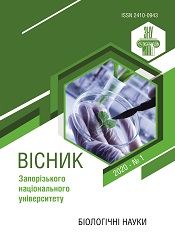Токсичність іонів важких металів як показник чутливості і стійкості рослин до абіотичних стресів: огляд
Анотація
Іони важких металів (ІВМ) знаходяться серед найбільш токсичних ксенобіотиків, котрі спричиняють як загальні, так і специфічні ураження організмів. Особливо це стосується елементів, токсичних у залишкових кількостях. Одні з таких ІВМ є предметом різнобічного вивчення (іони Cd2+), водночас інші викликають зацікавлення завдяки своїм особливим характеристикам (іони Ba2+). Часто дія ІВМ підсилюється впливом природних абіотичних факторів. Зроблено огляд загальних аспектів патологічної дії ІВМ. Розглядається використання іонних, протеомних, метаболічних складників; підкреслюється роль їхніх взаємозв’язків для встановлення генетичних детермінант стійкості. Звертається увага на спільні прояви адаптації до ІВМ та осмотичних стресів – засолення та водного дефіциту. Розглянуто токсичну дію іонів Cd2+ і Ba2+. Пропонується ідея використання іонів Cd2+ і Ba2+ у клітинній селекції для виділення форм, стійких до водного та сольового стресів. Наведено приклади отримання клітинних ліній рослин із застосуванням летальних для клітинних культур доз іонів. Варіанти відзначались комплексною стійкістю як до іонів селекції, так і до осмотичних стресів. Життєдіяльність за стресових умов контролювалась змінами метаболому та протеому і проявлялась у збільшенні клітинної маси, збереженні водного статусу, акумуляції вільного проліну, цукрів. При цьому параметри стійкості не втрачались зі збільшенням строку вирощування, а також зберігались у разі зміни умов культивування. Водночас метаболічні показники змінювались у відповідності до змін умов культивування. Такі характеристики, а також їхня хронологія можуть свідчити на користь існування перехресних сигнальних шляхів, котрі поєднують реакції стійкості до ІВМ і осмотичних стресів. Рослини, регенеровані із таких клітинних ліній, відзначались підвищеним рівнем осмостійкості. Нетрадиційний погляд на проблему розширює рамки традиційних підходів у разі створення вихідного матеріалу.
Посилання
(2) He Bing, Yang Xiao-e, Ni Wu-Zhong, Wei-You Zhang, Ye Hai-bo. Pb uptake, accumulation subcellular distribution in a Pb-accumulating ecotype of Sedum alfredii (Hance). J. Zhejiang Univ. Sci. 2003, 4, 474–479.
(3) Gabbrielli R., Gori P., Scala NNi toxicity on carnation (Dyanthus cariophyllus L. cv. Corrida) cell cultures. Selection Ni tolerant lines and effect of Ca and Mg. Plant Sci. 1995, 104, 225–230.
(4) Yong P., Macaskie L.E. Bioaccumulation of lanthanum, uranium and thorium and use of model system to develop a method for the biologically-mediated removal of plutonium from solution. J. Chem. Technol. Biotechnol. 1998, 71, 15–18.
(5) Rizvi A., Ahmed B., A. Zaidi A., Khan M.S. Heavy metal mediated phytotoxic impact on winter wheat: oxidative stress and microbial management of toxicity by Bacillus subtilis BM2, RSC Adv., 2019, 9, 6125–6142. RSC.
(6) Munir M., Khan Z.I., Ahmad K., Wajid K., Bashir H., Malik I.S., Nadeem M., Ashfaq A., Ugulu I. Transfer of heavy metals from different sources of fertilizers in wheat variety (Galaxy-13), Asian J. Biol. Sci. 2019, 12, 832–841. CrossRef CAS.
(7) Bhalerao S.A., Sharma A.S. Toxicity of nickel in plants Indian J. Pure Appl. Biosci., 2015, 3, 345–355. Search PubMed.
(8) Rizvi A., Zaidi A., Ameen F., Alumed B., AlKaftani M.D.F. Sadhir Khan M. Heavy metal induced stress on wheat: phytotoxicity and microbiological management. RSC Adv. 2020, 10. 38379-38403. DOI: 10.1039/D0RA05610C.
(9) Arnholdt-Shmitt B. Stress-induced cell reprogramming. A role for global genome regulation. Plant Physiol. 2004, 136, 2579–2586.
(10) Алексеев Ю.В. Тяжёлые металлы в почвах и растении. Ленинград: Агропромиздат 1987, 141 с.
(11) Hirt H., Casari G., Barta A. Cadmium-enhanced gene expression in suspension-culture cells of tobacco. Planta 1989, 179, 414–429.
(12) Lee S., Leustek T. The effect of cadmium on assimilation enzymes in Brassica juncea. Plant Sci. 1999, 141, 291–207.
(13) Chen S.L., Kao C.H. Cd induced changes in proline level and peroxidase activity in roots of rice seedlings. Plant Growth Reg. 1995, 17, 67–71.
(14) Chongpraditnum P., Mori S., Chino M. Excess copper induces Cu, Zn-superoxide dismutase in soybean root Plant Cell Physiol. 1993, 33, 239–244.
(15) Jouili H., El Ferjiani E. Changes in antioxidant lignifying enzyme activities in sunflower (Helianthus annuus L.) roots stressed with copper excess. C. R. Acad. Sci. D. 2003, 32, 639–644.
(16) Wang Q.H., Liang X., Dong Y.J., Xu L.L., Zhang X.W., Hou J., Fan Z.Y. Effects of exogenous nitric oxide on cadmium toxicity, element contents and antioxidative system in perennial ryegrass, Plant Growth Regul., 2013, 69, 11–20. CrossRef CAS.
(17) Pérez-Pérez M.E., Lemaire S.D., Crespo J.L. Reactive oxygen species and autophagy in plants and algae. Plant Physiol., 2012, 160, 156–164. CrossRef.
(18) Hordiman R.T., Jacoby B. Absorption and translocation of Cd in Bush beans (Phaseolus vulgaris) Physiol. Plant. 1984, 61, 670–674.
(19) Cutler J.M., Rains D.M Characterization of cadmium uptake by plant tissue. Plant Physiol. 1974, 54, 67–71.
(20) Серёгин И.В., Иванов В.Б. Физиологические аспекты токсического действия кадмия и свинца на высшие растения. Физиол. растений. 2002, 48, 606–630.
(21) Janicka-Russak M., Kabała K. Burzyński M. Different effect of cadmium and copper on H+-ATPase activity in plasma membrane vesicles from Cucumis sativus roots, J. Exp. Bot., 2012, 63, 4133–4142. CrossRef CAS.
(22) Kenderešová L., Staňová A., Pavlokin J., Ďurišova E., Nadubinská M., Ciamporová M. et al. Early Zn2+-induced effects on membrane potential account for primary heavy metal susceptibility in tolerant and sensitive. Arabidopsis species Ann. Bot. 2012, 110, 445–459. DOI: 10.1093/aob/mcs111.
(23) Fan L.-M., Wu W.-H., Yang Y.-Y. Identification and characterization the inward K+ channel in the plasma membrane of Brassica pollen protoplasts. Plant and Cell Physiol. 1999, 40, (8), 859–865.
(24) Rubio F., Nieves-Cordones M., Aleman F., Martinez V. Relative contribution of AtHAK5 and AtHAK1 to K+ uptake in the high-affinity range of concentrations. Physiol. Plant. 2008, 134, 598–608.
(25) Wang S.-M., Zhang J.-L., Flowers T.J. Low-affinity Na+ uptake in the halophyte. Suaeda maritime Plant Phys. 2007, 145, 559–571.
(26) Vasantha Pillay S., Rao V.S., Rao K.V.N. Effect of nickel toxicity in Hyptis suaveoles (L) Poit and Helianthus annuus L. Ind. J. Plant Physiol. 1996, 1, 153–156.
(27) Paunov M., Koleva L., Vassilev A., Vangronsveld J., Goltsev V.V. Effects of different metals on photosynthesis: cadmium and zinc affect chlorophyll fluorescence in durum wheat, Int. J. Mol. Sci., 2018, 19, 787, DOI: 10.3390/ijms19030787.
(28) Li L., Huang X., Borthakur D., Ni H. Photosynthetic activity and antioxidative response of seagrass Thalassia hemprichii to trace metal stress Acta Oceanol. Sin. 2012, 31, 98–108. DOI: 10.1007/s13131-012-0210-3.
(29) Kervesan S., Petrovic N., Popuvic M., Kandrac J. Nitrogen and protein metabolism in young pea plant as affected by different by different nickel, cadmium, lead, molybdenum. J. Plant Nutr. 2001, 24, 1633–1644.
(30) Joner E.J., Leyval C. Time-course of heavy metal uptake in maize and clover as affected by root density and different mycorrhizal inoculation regimes Biol. Fertil. Soils. 2001, 33, 351–357.
(31) Kirmani H.F., Hussain M., Ahmad F., Shahid M. Asghar A. Impact of zinc uptake on morphology, physiology and yield attributes of wheat in Pakistan, Cercetari Agronomice în Moldova, 2018, 51, 29–36. Search PubMed.
(32) Al-Yemeni M.N. Effect of cadmium, mercury, and lead on seed germination and early seedlings of Vigna ambacensis. Indian J. Plant Physiol. 2001, 6 2 (N.S.), 147–151.
(33) Ku Hao-Juan, Xi Jia-bin, Yang Zhang-yi. Effects of heavy metals on Sesbania rostrata suspension cultures obtained from roots, stems and leaves. Acta Sci. Nat. Univ. Sutyatseni Natur. Sci. 2001, 40, 84–87.
(34) Jackson R.J., Roth E.J., McClure P.R., Natanjo C.M. Selection, isolation and characterization of Cd-resistant. Datura innoxia Plant Physiol. 1984, 75, 914–918.
(35) Domazlicka E., Opatrny Z. The effect of cadmium on tobacco cell culture and the selection of potentially Cod-resistant cell lines. Biol. Plant. 1989, 1, 19–27.
(36) Gratao P.L., Pompeu G.B., Capaldi F.R., Vitorello V.A., Leo P.J., Ajivedo R.A. Antioxidant response of Nicotiana tabacum cv. Bright Yellow 2 cells to cadmium and nickel stress Plant Cell Tissue and Org. Cult. 2008, 94, 73–83 DOI: https //doi.org/10.1007/sl 1240-008-9389-6.
(37) Сергеева Л.Е., Михальская С.И., Комисаренко А.Г. Современные биотехнологии повышения устойчивости растений к осмотическим стрессам. Киев; Кондор, 2019, 160 c.
(38) Иванов А.А., Кособрюхов А.А. Изменение фотосинтетических характеристик и физиологических показателей у растений пшеницы при действии кадмия на фоне NaCl. Сел.-хоз. биол. Сер. Биол. растений. 2009, 3, 104–109.
(39) Marόti M., Bognár J. Growth response of plant callus tissue to toxic heavy metal compounds and ion contaminating the environment. Acta Bot. Hung. 1985, 31, 251–259.
(40) Nakazawa R., Ikawa M., Yasuda K., Takenaga H. Synergistic inhibition of the growth of suspension cultured tobacco cells by simultaneous treatment with cadmium and arsenic in relation to phytochelatin synthesis. Soil Sci. and Plant Nutr. 2000, 46, 271–275.
(41) Surosz W., Palinska K.A. Ultrastructural changes induced by selected cadmium and copper concentrations in the cyanobacterium Phormidium: interaction with salinity. J. Plant Physiol. 2000, 187, 643–650.
(42) Tamás L., Mistrik I., Huttová J., Halusková L., Valentovicová K., Zelinova V. Role of reactive oxygen species-generating enzymes and hydrogen peroxide during cadmium, mercury and osmotic stresses in barley root tip. Planta 2010, 231, 221–231. DOI: 10.1007/s00425-009-1042-z.
(43) Hernandez L.E., Villasante C.O., Montero-Palmero M.B., Escobar C. Carpena R.O. “Heavy metal perception in a microscale environment: a model system using high doses of pollutants” in Metal toxicity in plants. Perception, signaling and temediation; eds D.K. Gupta and L.M. Sandalio (Berlin: Heidelberg: Springer-Verlag), 2012, 23–37. DOI: 10.1007/978-3-642-22081-4_2.
(44) Qing G., Zhai X.-G. & Han Z.-X. Cloning and sequence analysis of new gene coding drought tolerance, LEA3 from Tibet hull-less barley. Zuowu xuebao=Acta Agr. Sin. 2007, 33, 292–296.
(45) Tioleter D., Jaquinod M., Mangavel C., Passirani C., Saulner P., Manon S., Teyssier E., Payet N., Avelange-Macherel M.-H., Macherel D. Structure and function of a mitochondrial late embryogenesis abundant protein by desiccation. Plant Cell, 2007, 19, 1580–1587.
(46) Verslues P.Е. Bray E.A. LWR1 and LWR2 are required for osmoregulation and osmotic adjustment in Arabidopsis. Plant Physiol. 2004, 136, 2831–2842.
(47) Nakashima K., Ito Y., Yamaguchi-Shinozaki K. Transcriptional regulatory networks in response to abiotic stress in plants. Physiol. Plant. 2009, 149, 88–95. DOI: 10.1104/pp.108.129791.
(48) Shameer K., Ambika S., Varghese S.M., Karaba N., Udayakumar M., Sowdhamini R. STIFDB – Arabidopsis stress-responsive transcription factor Data Base. Inr. J. Plant Genomics. 2009: 583429. DOI: 10.1155/2009/583429.
(49) Гамзикова О.И., Барсукова В.С. Полиморфизм и характер наследования устойчивости пшеницы к избытку никеля. Физиол. и биохимия культ. растений 1993, 25, 8–14.
(50) Howden R., Goldsbrough P.B., Andersen C.R., Cobbett C.S. Cadmium-sensitive cad1 mutants of Arabidopsis thaliana are phytochelatine deficient. Plant Physiol. 1995, 107, 1059–1066.
(51) Howden R., Andersen C.R., Goldsbrough P.B., Cobbett C.S. A cadmium-sensitive, glutathion deficient mutant of Arabidopsis thaliana Ibid. 1995. 107, 1067–1073.
(52) Pena L.B., Barcia R.A., Azpilicueta C.E., Méndez A.A., Gallego S.M. Oxidative post translational modifications of proteins related to cell cycle are involved in cadmium toxicity in wheat seedlings.Plant Sci. 2012, 196, 1–7. DOI: 10.1016/j. plantsci.2012.07.008.
(53) Singh S., Parihar P., Singh R., Singh V.P., Prasad S.M. Heavy metal tolerance in plants: role of transcriptomics, proteomics, metabolomics and ionomics. Frontiers in Plant Science 2016, URL: https://doi.org/103389/fpls 201501143.
(54) Emamverdian A., Ding Y., Mokhberdoran F., Xie Y. Heavy metal stress and some mechanisms of plant defense response. Sci. World J., 2015. DOI: 10.1155/2015/756120.
(55) Сергеева Л.Е. Клеточная селекция с ионами тяжёлых металлов для получения генотипов растений с комплексной устойчивостью к абиотическим стрессам. Киев: Логос, 2013, 211 с.
(56) Sergeeva L.E., Bronnikova L.I. Cadmium ions in cell selection for obtaining wheat cell forms tolerant to water stress. Visn. Cherkassy Univ. Ser. Biology. 2019, 2, 74–80. DOI: 10.31651/2076-5835-2018-1-2019-2-74-80
(57) Sergeeva L.E., Bronnikova L.I. Cell selection with barium ions for obtaining genetically modified salt tolerant tobacco forms. Visn. Cherkassy Univ. Ser. Biology. 2020, 1, 71–78. DOI: 10.31651/2076-5835-2018-1-2020-1-71-78.
(58) Naika M., Shameer K., Mathew O.K., Gowda R., Sowdhamini R. STIFDB2: An update version of plant stress-responsive stress signals, stress-responsive transcription factors binding sites and stressresponsive genes in Arabidopsis and rice. Plant Cell Phys. 2013, 54:e8. DOI: 10.1093/pcp/pcs185.
(59) Тищенко Е.Н., Михальская С.И. Агробактериальная трансформация подсолнечника. Физиол. и биохим. культ. растений. 2006, 38. 187–196.
(60) Amini S., Ghobadi C., and Yamchi A. Proline accumulation and osmotic stress: an overview of P5CS gene in plants, Journal of Plant Molecular Breeding, 2015, 3, 44–55. Search PubMed.
(61) Fasani E., Manara A., Martini F., Furini A., DalCorso G. The potential of genetic engineering of plants for the remediation of soils contaminated with heavy metals. Plant Cell Environ. 2018. 41, 1201–1232. 10.1111/pce.12963 [PubMed] [CrossRef] [Google Scholar].

 ISSN
ISSN 




